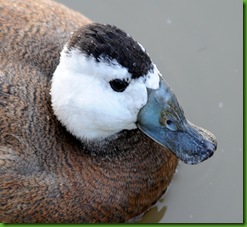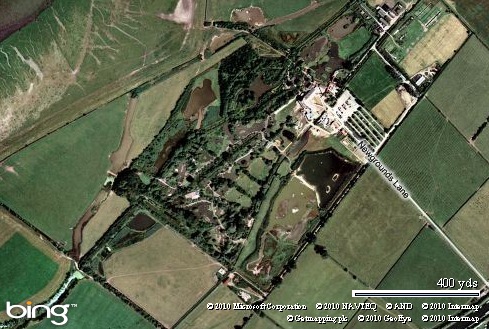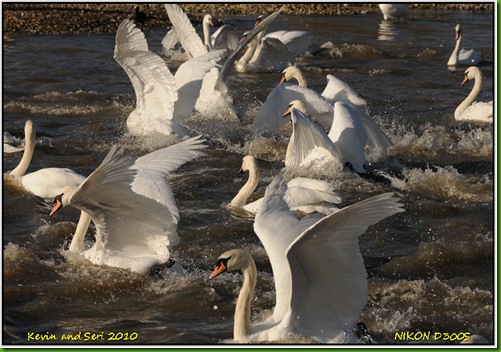Slimbridge Wildfowl and Wetlands Trust site
19th November 2010 and the lovely Seri took the day off work, we wanted to go to the Wildfowl and Wetland Trust site at Slimbridge in Gloucestershire. We awoke to A foggy day and a forecast that the fog was here for the rest of the day, but joy of joys, Slimbridge should be OK. So we set off, fog and slow moving traffic for most of the 90 mile trip, several stops on the way but we got there eventually.
As we arrived in the carpark we were surprised to see that there were a lot of people already there. Slimbridge is a world famous conservation site, which hosts an amazing array of wildfowl from all over the world. Including the now famous Nene (pronounced Neh Neh) or Hawaiian Goose, which was rescued from the point of extinction by Sir Peter Scott, late lamented son of Scott “of the Antarctic” and founder of Slimbridge. Given its fame it is no surprise that the place is always busy, despite the high entrance fee of £9.75 per person. We don’t go often :-)
This was our second trip to Slimbridge this year, our previous visit was in the height of summer in August, which, as any British person will tell you, is when you can almost always guarantee dark skies and rain. Ironically it was a touch easier, therefore, to use the cameras this trip than last :-)
One of the things we love about this location is that, not only do you get to see exotic species from all over the planet, with their vibrant colours and design, but also you get to be really close to indigenous UK and passage migrant species which use the spot as a feeding station.
It is a great thrill to stand within a few metres of Eider and Goldeneye ducks, as well as Bewick, Mute and Whooper Swans, Tufted Ducks, Jackdaw, Rook, Dunnock, Woodpigeon and many others. All of these species we have photographed elsewhere in our travels, but Slimbridge seems to make them more relaxed and approachable.
The main pond, adjacent to the visitor centre is host to a large number of Mute Swans. There must a hundred or so, all mixed up with the Tufted Ducks, Common Shelduck and their more colourful cousins the Ruddy Shelduck. All was peace and quite, Swans grooming and bathing peacefully, occasionally a little quarrel between adults and youngsters and then suddenly all hell breaks loose. All of the Swans, began beating their wings against the water furiously and dashing up and down the lake. The noise was deafening, and the water instantly became like a boiling cauldron. Incredible to see, and we have no idea as to why they went crazy……
We visited the hides on this trip, which we had missed last time around, frankly not great, they are poorly designed and too far away from the birds on the site. That said we saw Curlew, several hundred Wigeon and a Peregrine Falcon. For reasons known unto the managers of Slimbridge the one hide Seri wanted to visit closes in the winter months to “prevent disturbance of over wintering species” this seems to be a little silly to us, as the whole point of hides is to prevent such disturbance. A bit of overkill methinks………
Anyway back into the main reserve for us, at this point we were feeling a little let down by the visit, a quick trip to see the Flamingos (there are several breeds at Slimbridge) and you cannot help but feel better towards the place. Even better though, on our last trip in August we had specifically gone in search of Mandarin and Wood duck, with no luck. This time we found them the male Mandarin being all feisty and showy. Mandarins are evolved to be show offs :-) if they had a motto it would surely be “I pose therefore I am” LOL delightful little things to look at……..
We continued our walk around as much as my poor legs can manage of the reserve, viewing numerous breeds of Crane, geese and ducks of all colour size shape and attitude all over the place. Slimbridge has a population of the now rare Eurasian Crane, which are all hand reared, using glove puppets, to reduce their dependence on man, with the intention of eventual re-introduction of a breeding population into the UK.
Great things to see therefore in their present semi-captive state.
Conservation can be, in and of itself, a contentious issue , as I am always reminded when I see the odd looking little duck to the right. This is the very rare White Headed Duck, numbers of which have plunged in recent years. Many of these little fellows are to be seen at Slimbridge.
, as I am always reminded when I see the odd looking little duck to the right. This is the very rare White Headed Duck, numbers of which have plunged in recent years. Many of these little fellows are to be seen at Slimbridge.
The principle reason for their reduction in numbers is not, as one may think, hunting, habitat loss or any of these issues, although I am sure, as with many species these will all play a part, but no, the main reason is that they are hybridising with Ruddy Duck, an American species which now lives and breeds in the United Kingdom.
What answer do the powers that be have to prevent this “decline”? Wholesale slaughter of the Ruddy Duck population in the UK and I believe in the EU. Note the quotation marks around decline…… One could argue with some veracity that they are not in decline, but are rather evolving into a new breed…
We always find it incredible that wholesale slaughter of a breed or species is touted as a tool in conservation. To us they seem to be mutually exclusive terms…….. If we were to remove all of the “non-native” species from the United Kingdom one wonders what, if anything, would remain?? Naive you say – perhaps so – but there comes a point when you have to say – it’s been here long enough to be considered a part of our fauna……. As you can see – visiting Slimbridge makes one think :-)
Slimbridge also houses a troop of Otters, and we were lucky enough to be there at feeding time when the female adult and her three well grown daughters were being fed with all manner of fishy goodness…. Great to see them out in the open. There was a talk going on during the feeding spectacle in which it emerged that the Otters are American – Northern River Otters, and not Eurasian. Why? not a clue and no convincing reason seemed forthcoming. Anyway who cares, they are remarkable and beautiful creatures.
There is also an elusive beaver on site, elusive in that it just never seems to come out LOL
If you visit, go to the Crane site and you will see a couple of baskets on a pivot point. There is a sign on the baskets asking “should we re-introduce beavers to the UK?” I paraphrase – the idea is that visitors place stones into whichever basket suits their answer yes or no….. As one basket is heavier so, naturally the baskets will act as a weighing scale.
Great idea, with one significant problem. As we walked around the reserve we found there were quite a few stones in the no side of the scale – which actually fits our views on this question. A couple of hours later we went back to the same spot and all of the stones in the no side had been removed leaving none in that basket.
In all honesty one has to ask: Why ask the question if you have no interest in the results? – A fundamentally dishonest and insulting practice.
Criticism ended :-)
Slimbridge is a really special place to visit – it is too expensive (use the restaurant at your financial peril) and the hides are not great, but the sheer volume of wildfowl from all over the world, as well as the UK just makes this a must visit for anyone wishing to see exotic birds and wildlife close-up. In addition the knowledge of the good work they do there with regards to conservation of the many endangered species of wildfowl makes one thankful for their existence. Great place – visit if you can – but don’t forget your wallet…….. our day ended with a 2 and a bit hour drive home through pea soup fog. Great day out – hard work :-)
All in all we took over 2,600 shots on this visit using 3 cameras – Nikon D50, D200, D300s– 1882 of which we added to our extensive collection.
Click the above image to see a slideshow of photographs from our recent trip to Slimbridge.



No comments:
Post a Comment
Thanks for viewing our humble blog! All comments are moderated.